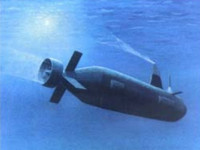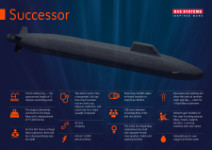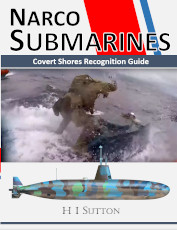Astute's successor: SSN(R)
 With the last of seven Astute Class submarines now under construction, Royal Navy planners are already looking to the next class of British attack submarines. Although there is little-to-nothing on this subject on the internet, it is a good time to start an article which pieces together what we can deduce from unclassified sources and guesswork about the MUFC (Maritime Underwater Future Capability) to replace the Astute Class. The article will be updated over time.
With the last of seven Astute Class submarines now under construction, Royal Navy planners are already looking to the next class of British attack submarines. Although there is little-to-nothing on this subject on the internet, it is a good time to start an article which pieces together what we can deduce from unclassified sources and guesswork about the MUFC (Maritime Underwater Future Capability) to replace the Astute Class. The article will be updated over time.
The MUFC program emerged out of the Future Attack SubMarine program of the early 2000s (FASM). MUFC has moved into the initial Concept Phase in 2018 and is spending about £20 million in 2018-19, a fraction of the budget for other submarine programs.
British politicians have a history of being too slow to order successive submarine classes. The break in submarine building between the Vanguard and Astute Classes was costly as shipyard expertise is heavily influenced by the continuity of work. With the last of the Astute Class SSN being commissioned in ~2024, and the four Dreadnought Class SSBNs expected by the mid-2030s, then the Astute Successor SSN(R) would provisionally start joining the fleet ~2040, by which time HMS Astute will be 30 years old.
There are already worrying signs for the Royal Navy however; in May 2018 the Ministry of Defence agreed to delay by two years the development of the Astute-class submarine replacement (SSN(R) = Submersible Ship Nuclear Replacement (SSNR)). Additional delays may come from the knock-on effect of Astute delays; the Astute, Dreadnought and MUFC submarines will likely be constructed in the same facility so delays to Astute may in turn delay Dreadnought, which may delay SSN(R).

Concept of operations
With the focus returning to near-peer or super-power adversaries, the SSN(R) will likely be deep-water orientated in the same way that the next generation of US Navy boat will be. This contrasts with Astute and Virginia Classes which are expected to operate in both open water and restricted waters. Of course, SSN(R) will be a credible inshore platform, but it won’t be the design focus. There are likely to be several factors driving this shifting requirement:
a) The Russian Navy submarine force is seen as more of a threat than in the past 25 years, both in terms of capability and actions. As more Pr.885M SEVERODVINSK-M Class SSGNs join the fleet in the mid-2020s the quality of the threats faced on a day-to-day basis in the North Atlantic will massively increase.
b) New Russian weapon systems, notably the Poseidon Intercontinental Nuclear-Powered Nuclear-Armed Autonomous Torpedo and various unmanned underwater vehicles (UUVs) will be deep-diving threats. New weapons will need to be developed to counter these.
c) Many of the missions which currently bring SSNs inshore are likely to diminish by 2040. ISR (Intelligence Surveillance and Reconnaissance) will be conducted from ever greater ranges, often by other vehicles (UAVs, UUVs, USVs, cyber…). Special Forces capabilities are ultimately unlikely to win out.
Get The essential guide to World Submarines
This Covert Shores Recognition Guide Covers over 80 classes of submarines including all types currently in service with World Navies.Check it out on Amazon
Overall layout
In the same way that the Astute Class resembles the preceding Vanguard Class SSBN, many clues to SSN(R)’s appearance are likely to be found in the Dreadnought Class SSBN currently starting construction. The family resemblance is likely to be greater as the design gap should be shorter, and there will likely be a strong motivation to standardize many components between the classes. The design will almost certainly utilize PWR3 (Pressurized Water Reactor 3) nuclear propulsion from the dreadnought Class.
Therefore the SSN(R) will likely resemble the Dreadnought Class except with the missile compartment removed. We are unlikely to see vertical launch tubes with the Royal Navy seeming to prefer tube launching cruise missiles (despite BAE Systems being involved in construction of VLS for the US Navy’s Virginia Class).
The bow will have the characteristic British chined form with a chin-mounted sonar. Six torpedo tubes will shoot forward past the array with the torpedo room in the lower part of the pressure hull.
Like other British submarines, construction will be single-hull but with a large casing running along the top. Expect the anechoic coating to be shaped similar to other RN boats.
The large sail for non-penetrating masts will be more tapered than the Astute with, and the tail will have X=form rudders and a pump jet propulseur almost identical to the Dreadnought.
1.  2.
2.  3.
3. 
- & 2. early concept artworks of FASM, now dated. 3. BAE Systems image of Dreadnought Class SSBN
Size
The SSN(R) will be roughly 25% larger than the Astute Class due to the newer machinery borrowed from the Dreadnought, a the need to carry more extensive torpedo defenses.
Mission fit
Mission specific equipment may include the masts which will be the modular non-penetrating type. This will also facilitate rapid upgrade.
It is unclear whether a hangar capability will be designed-in, although we can speculate that it could potentially also be used for large UUVs, or additional weapons.
THE book on Special Forces subs Covert Shores 2nd Edition. A world history of naval Special Forces, their missions and their specialist vehicles. SEALs, SBS, COMSUBIN, Sh-13, Spetsnaz, Kampfschwimmers, Commando Hubert, 4RR and many more.
Check it out on Amazon
Crew
The boat will be much more automated than current NATO SSNs, driven by the need to have a smaller crew. Current Royal Navy (and US Navy) boats have comparatively large crews which traditionally has been seen as an advantage, but challenges in submariner recruitment and retention are being felt. People who worry that smaller crews will sacrifice expertise and potentially cause career path challenges are justified. But the future trend seems clear and its smaller crews. When a common argument for not having more submarines is that the UK doesn’t have enough submariners to crew them then it’s clear that something is wrong.
The machinery space will be supported by fewer technicians, and the tasks of diving, driving and navigating the boat will also be increasingly automated, continuing the trend of fewer specialisms in the control room. Forward, the torpedo room will likely be fully automated, with the payloads (torpedoes, UUVs,…) also requiring little or no underway maintenance.
Having said this, the control room will likely still be equipped with a relatively generous number of multi-function control stations to allow human input into fighting the boat.
The crew are likely to have individual berths with unisex facilities.
There will be better training and simulation capabilities on board including Virtual Reality and Augmented Reality. This should cover tactical/mission content as well as routine operations, and will help keep the crew at higher states of readiness. And it could potentially provide mean training hours than the opposing boat's crew.
The World's ONLY Guide to
Narco Submarines
10 years of research, analyzing over 160 incidents, condensed into a handy guide. This unique book systematically breaks down the types and families. With detailed taxonomy, recognition 3-views, profiles and photos. Available on Amazon
Related articles (Full index of popular Covert Shores articles)

 Project 885 'YASEN' (Severodvinsk Class) SSGN. w/Cutaway
Project 885 'YASEN' (Severodvinsk Class) SSGN. w/Cutaway

 Poseidon Intercontinental Nuclear-Powered Nuclear-Armed Autonomous Torpedo
Poseidon Intercontinental Nuclear-Powered Nuclear-Armed Autonomous Torpedo

 Attack Class
Attack Class

 SMX-31 future submarine concept ('The Electric') w/Cutaway
SMX-31 future submarine concept ('The Electric') w/Cutaway

 SNLE-3G next-generation French SSBN
SNLE-3G next-generation French SSBN

 A-26 Class attack submarine. w/Cutaway
A-26 Class attack submarine. w/Cutaway

 Project 955A 'BOREI-A' Ballistic Missile Submarine. w/Cutaway
Project 955A 'BOREI-A' Ballistic Missile Submarine. w/Cutaway

 Project 705 'ALFA' class attack submarine. w/Cutaway
Project 705 'ALFA' class attack submarine. w/Cutaway

 USS Jimmy Carter (SSN-23) Special Mission submarine
USS Jimmy Carter (SSN-23) Special Mission submarine

 HUSKY Class future attack submarine
HUSKY Class future attack submarine

 Project 09852 Belgorod Special Mission submarine (spy sub). w/Cutaway
Project 09852 Belgorod Special Mission submarine (spy sub). w/Cutaway

 Harpsichord AUV
Harpsichord AUV

 Cephalopod armed extra-large UUV
Cephalopod armed extra-large UUV
 Turbinia, the first steam turbine boat (1894)
Turbinia, the first steam turbine boat (1894)







